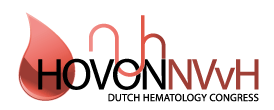One year of Orphan Drug Access Protocol for the use of sutimlimab in cold agglutinin disease
- Receipt of grants/research supports The ODAP is financially supported by Zorgverzekeraars Nederland via Medicijn voor de maatschappij
- Other support (specified) travel grant (for a conference) from Sanofi
Cold agglutinin disease (CAD) is a rare chronic complement-mediated auto-immune hemolytic anemia with an estimated prevalence of approximately 200 persons in the Netherlands. Sutimlimab (Enjaymo®; Sanofi), a complement-C1s antibody, was shown effective to treat hemolysis in CAD in three clinical trials and received EU marketing authorization in November 2022. Sutimlimab is given long-term every 2 weeks intravenously. However, it remains unclear which patients will benefit most from this expensive treatment compared to currently available options such as rituximab or immunochemotherapy. Supported by Medicijn voor de Maatschappij, in a collaboration between academia, health insurance companies and pharma, a new method was developed: the Orphan Drug Access Protocol (ODAP, https://medicijnvoordemaatschappij.nl/odap-orphan-drug-access-protocol). The ODAP pilot aims for faster but controlled access to orphan drugs with limited evidence. The ODAP for sutimlimab started in august 2023.
A monthly indication committee discusses candidates using predefined indication criteria for starting treatment in phase 1. After 3 months, each case is discussed again, using predefined effectiveness criteria to decide if this patient can proceed to to phase 2 (long term treatment). Essential clinical data including patient-reported-outcomes are collected in a central database and samples are biobanked for biomarker development. The ODAP will run for a minimum of 3 and a maximum of 5 years. The results, including a Health Technology Assessment (HTA), will be used in a joint assessment by health insurance companies (CieBAG) to decide on and sutimlimab’s position in the treatment of CAD patients in the Netherlands, and according suitability and conditions for reimbursement on a group level.
Within the ODAP, sutimlimab became available < 10 months after EMA approval. So far, 8 patients were discussed in the indication committee of whom 6 patients were included in the ODAP. Three of these 6 received sutimlimab as post-trial-access. Five patients are currently still being treated with sutimlimab (median duration of sutimlimab in ODAP + range). One patient stopped after three months (phase 1) due to lack of effectiveness. Addtional patients were pre-discussed informally but were not discussed formally in the committee meeting because they did not meet the inclusion criteria
The ODAP approach led to fast yet protocolized post-approval access to Sutimlimab for CAD patients in the Netherlands. It is too early to draw conclusions about the results of the ODAP sutimlimab. We can conclude that the ODAP approach might be a suitable access route for novel drugs for orphan diseases, in this case CAD, enabling appropriate use. This approach required a collaboration between involved medical professionals, health insurance companies and pharma.

